The Fullest Guide On Location-Based AR Apps Development
Updated 17 Oct 2023
15 Min
18391 Views
A few years ago, the world went crazy for Pokemon Go. And while the incredible popularity of this game is slowly decreasing, augmented reality has become a fresh trend in the tech world and is confidently seizing market share. In 2020, the AR market reached more than $14.1 billion and is expected to be $209.2 billion by the end of 2022. The number of AR users reached 1 billion in 2020 and keeps growing.
Besides the game industry, many other business areas can profit from implementing augmented reality apps. One of the types of augmented reality called location-based or GPS based augmented reality will be in the spotlight of this article.
What is Location Based Augmented Reality
Location-based AR is also known as markerless, position based and geo-based augmented reality. In contrast with marker-based AR, it doesn't need special markers to identify the place where a virtual object should appear.
It primarily relies on GPS, accelerometer, digital compass and other technologies to identify phone's location and position with a high level of accuracy. Modern devices are mostly equipped with these sensors, so the augmented reality is available for every mobile device owner.
The biggest question is how augmented reality works and how it gets the information about the location. The mechanism of work of such an app depends on real-time positioning systems (RTLS). Thus, the app first uses sensors to obtain data about the user’s current location and changes. Further, by connecting the received information with points of interest (POI), the app determines augmented reality geolocation and how and where to add virtual data to the real world. So if the user is close enough to the point of interest, the augmented reality content overlaps the camera image.
And the last important point is the technique of connecting the dots. The connection between sensors and POI should be correct for augmented reality to look natural. If all technical requirements are met, you will get the perfect application in which augmented reality looks raw and alive.
Markerless AR can be divided into outdoor and indoor. Outdoor augmented reality uses GPS, while indoor recognizes the current location of a mobile device with the help of beacons.
The biggest players in the tech industry predict a great potential in AR and continue to develop software for creating AR applications. The arrival of such powerful tools like Apple's ARKit and Google's ARCore made it much easier for developers to create their own AR apps. Being both released in 2017, these tools got enhancements this year.
Geo Based AR’s Impact on Different Areas
AR technology can offer much more than just an incredible gaming experience. Here's the list of industries that can benefit from creating AR mobile application.
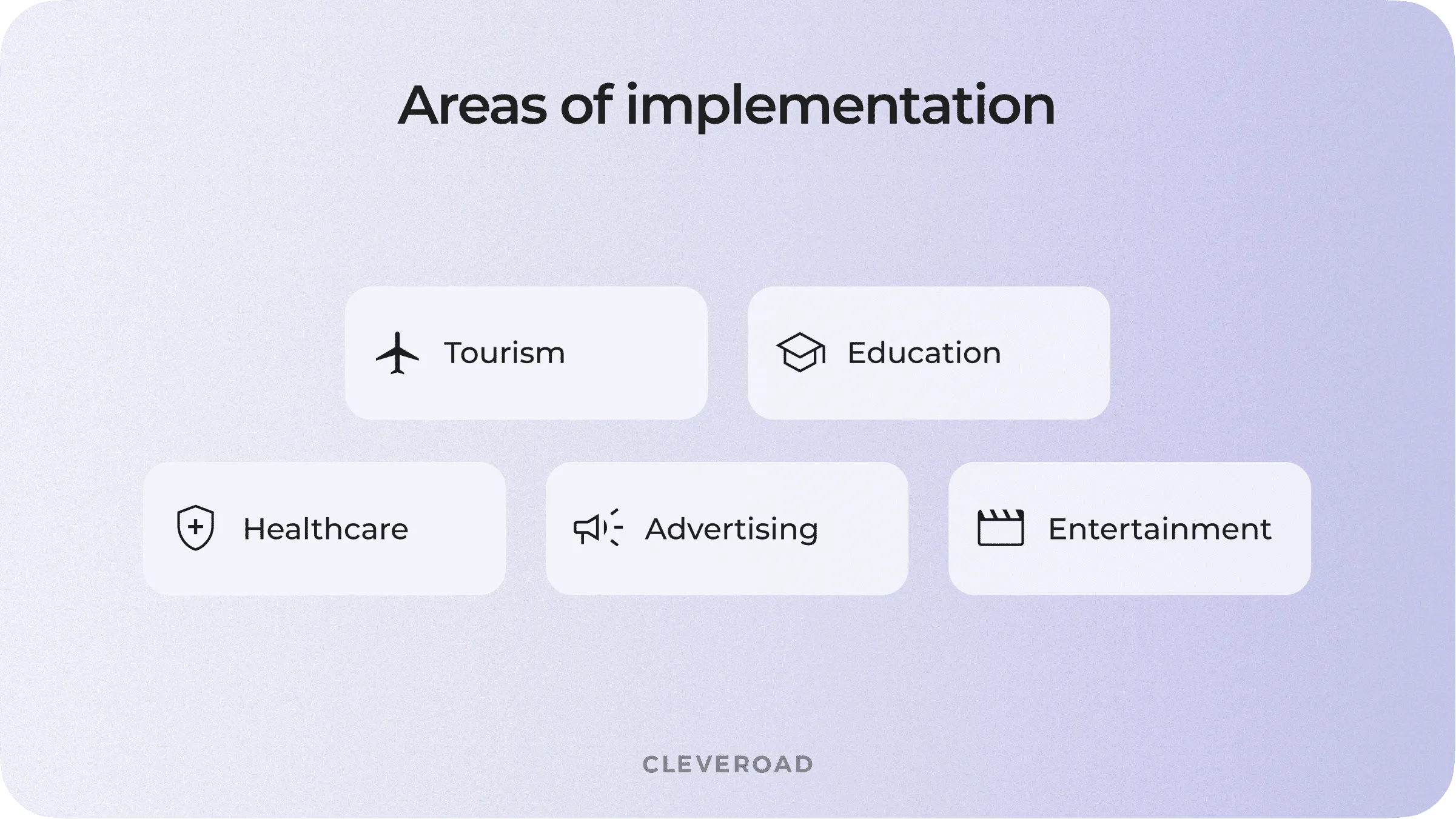
The list of areas where you can implement location-based AR
Tourism. Using location-based markerless augmented reality can become a great way of improving the traveling experience. Hence, now it is widely used, particularly in this sphere. It helps tourists discover new places and quickly find the most popular sightseeing in real-time mode using their mobile devices. Navigation applications with location-based augmented reality dramatically improve the effectiveness of navigation system. For instance, a traveler can find the nearest McDonalds by simply pointing the camera at the street.
Education. There is no denying that colorful and animated 3D or 2D objects are much more interesting than boring information from books! That's why the arrival of augmented reality had a major impact on the educational industry. Even though the marker-based AR is more common in this area, use cases of location-based AR also occur. Astronomy is a great field for implementing such types of AR, and soon we'll discover the best examples of such apps.
Healthcare. Beside the undisputable utility of marker-based AR for the healthcare industry, location-based AR can also come in handy. Consider an AED4EU as an example. This application identifies the nearest points of automated defibrillators and builds the best route to them. It will help to save lives of people who have suddenly fainted.
Advertising. Augmented reality introduces a whole new way of promoting goods and services. Many companies began using AR in advertising due to several reasons. It is much cheaper than traditional printed ads and stimulates customers to buy goods or services by introducing a new way of AR experience. The great power of location-based augmented reality on mobile phones can be used to enhance hyperlocal advertising. Just imagine, a user points the camera of the smartphone at the street, and at a glance, an AR app shows the information about current discounts or special offers in establishments nearby.
Entertainment. We won't talk much about this area, because we already mentioned it several times. Putting virtual objects into the real world is funny, therefore gaming and entertainment seem to be industries gaining the most profit from implementing location based AR technology. The growing interest in location-based augmented reality can be illustrated by many companies willing to create AR mobile games. The Next Games studio in collaboration with AMC introduced the AR game Walking Dead: Our World that put users into the post-apocalyptic zombie world. Mossland app, geared towards combining markerless AR, blockchain and real estate, is expected to arrive in 2019.
AR's prospects
Interest in augmented reality appeared long ago, but now everyone has begun to understand the meaning of this invention en masse. From simple entertainment, AR has turned into a handy feature that is used in many areas.
The giant companies Apple, Google, and Microsoft, are investing a lot of money in developing AR solutions that will be accessible and interesting to users. Several major projects have already been announced, such as Apple's AR glasses, which will be able to synchronize with the phone and transfer the necessary information.
Against this background, the introduction of AR into apps of small, medium, and large businesses will also massively increase. According to the forecasts of Statista, mobile augmented reality market revenue, which is 13 billion US dollars in 2022, will be $26 billion by 2025.
Thus, AR, Virtual Reality (VR), and Mixed Reality (MR) are genuinely the technologies of the future, which are recognized by world leaders in the IT field. Therefore, it is worth considering implementing such a solution today when augmented reality is climbing the ladder of popularity.
Examples of Augmented Reality Apps Available on the Market
Pokemon Go with approximately 100 million downloads and $1.2 billion revenue, needs no introduction. Instead, consider the best location-based AR examples that became popular among users.
Google Maps Live View
A relatively new feature in Google Maps and a great example of an AR geolocation app that allows users to navigate in which direction to move quickly. They can turn on augmented reality and view information about the objects around them.
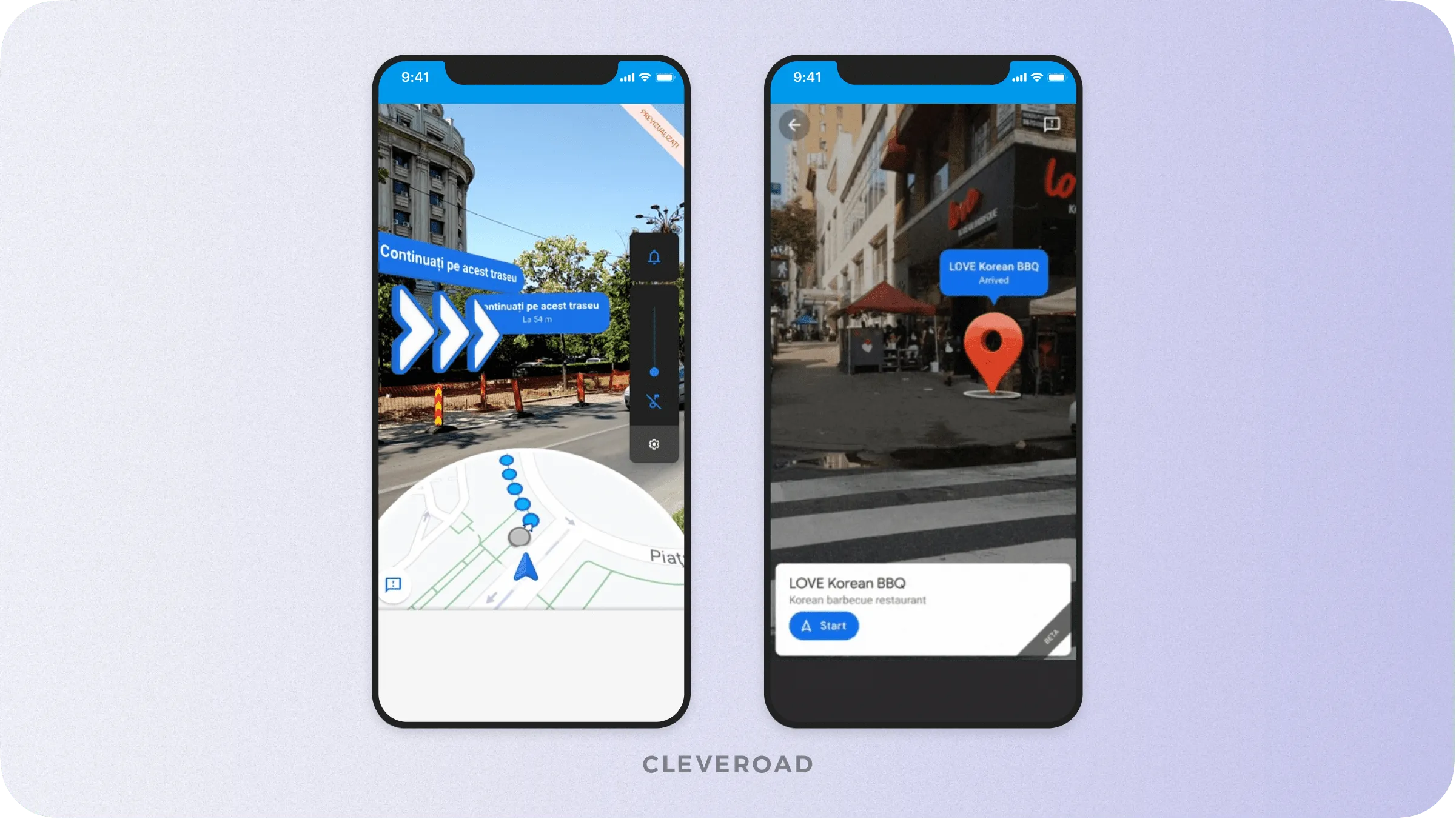
Google Maps Live View
This information includes the names of buildings and attractions, the distance to them from the point where the user stands, the opening hours of the establishments he passes by, the services they offer, and even separate buttons for viewing photos of visitors and their reviews.
Just a line
Just a Line is an experimental geolocation augmented reality project from Google. Its principle is as follows: after calibrating the application, you draw any image, and, stepping back, you can admire your creation. But that's not all. By going around your drawing in a circle, you can view it in 3D space. Moreover, as you move around the resulting drawing, you will be able to stretch the lines and change the final result.
Ingress
Ingress is another entertainment app using GPS navigation. It is a multiplayer online game released by Niantic Labs that created PokemonGO. All players are divided into Enlightened and Resistance factions and fight with each other in order to control virtual territories. The main point of this game is to capture the largest possible number of portals, which are usually situated in places of cultural significance. Ingress uses data obtained from Google Maps and available on both iOS and Android.
Wikitude World Browser
Wikitude World Browser is another product of Wikitude, the company known for it's Augmented Reality SDK. This 'first AR browser for smartphone users' has a wide range of features that can come in handy for tourists.
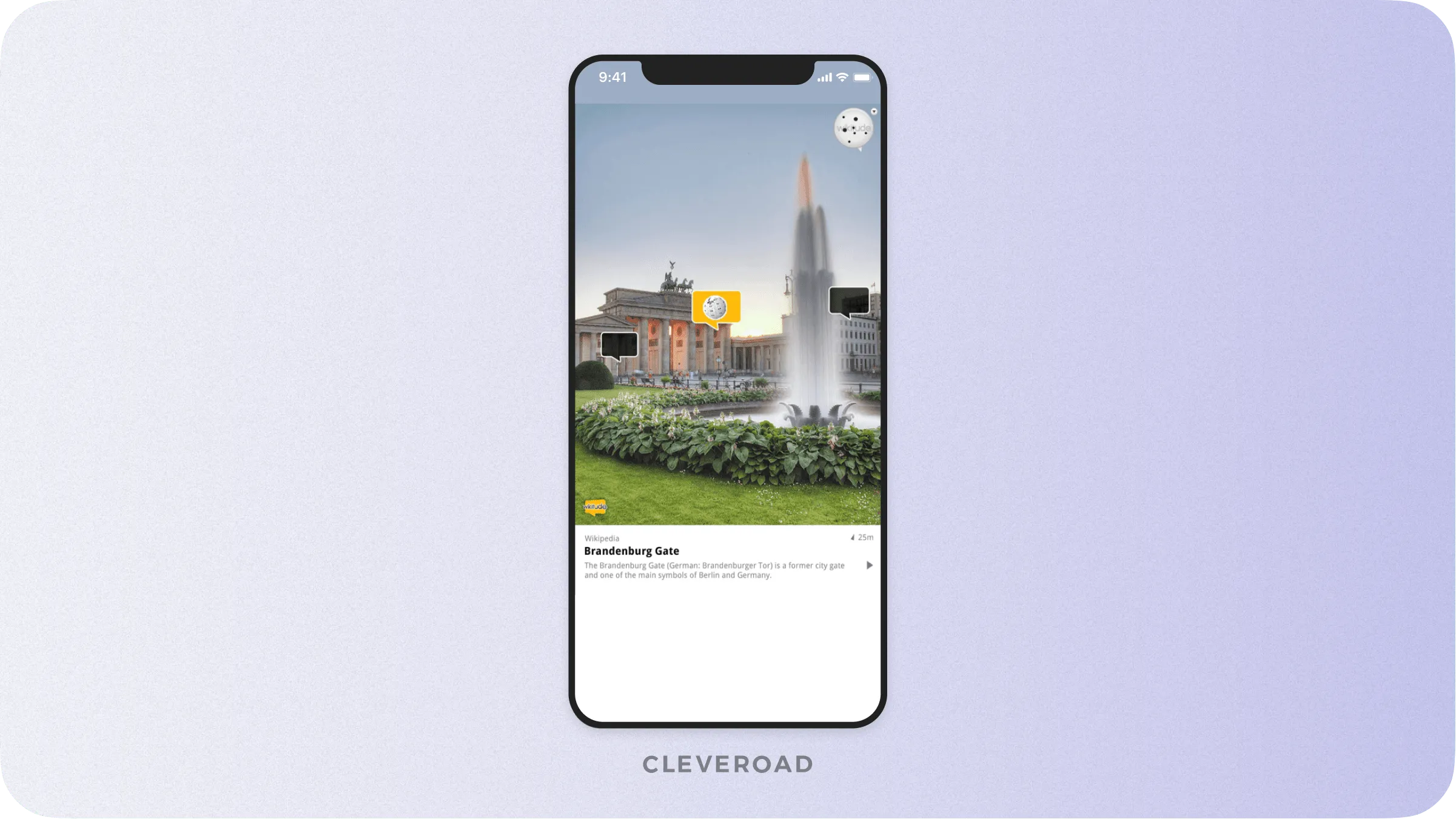
Wikitude World Browser - another example of location-based AR
For instance, you can view the information about the particular sightseeing by just pointing the camera at this place or find a way to the nearest mall and so forth. World Browser also offers coupons and shows discounts from stores nearby. The integration with such popular services like Yelp, Trip Advisor, Hotels.com, and Qype enables travelers to quickly check all needed information.
Sky Guide
Sky guide from Fifth Star Labs LLC is an educational tool for those who are fond of astronomy. It is a great AR location based example that identifies the user's location to show detailed information about star constellations visible from the current point.
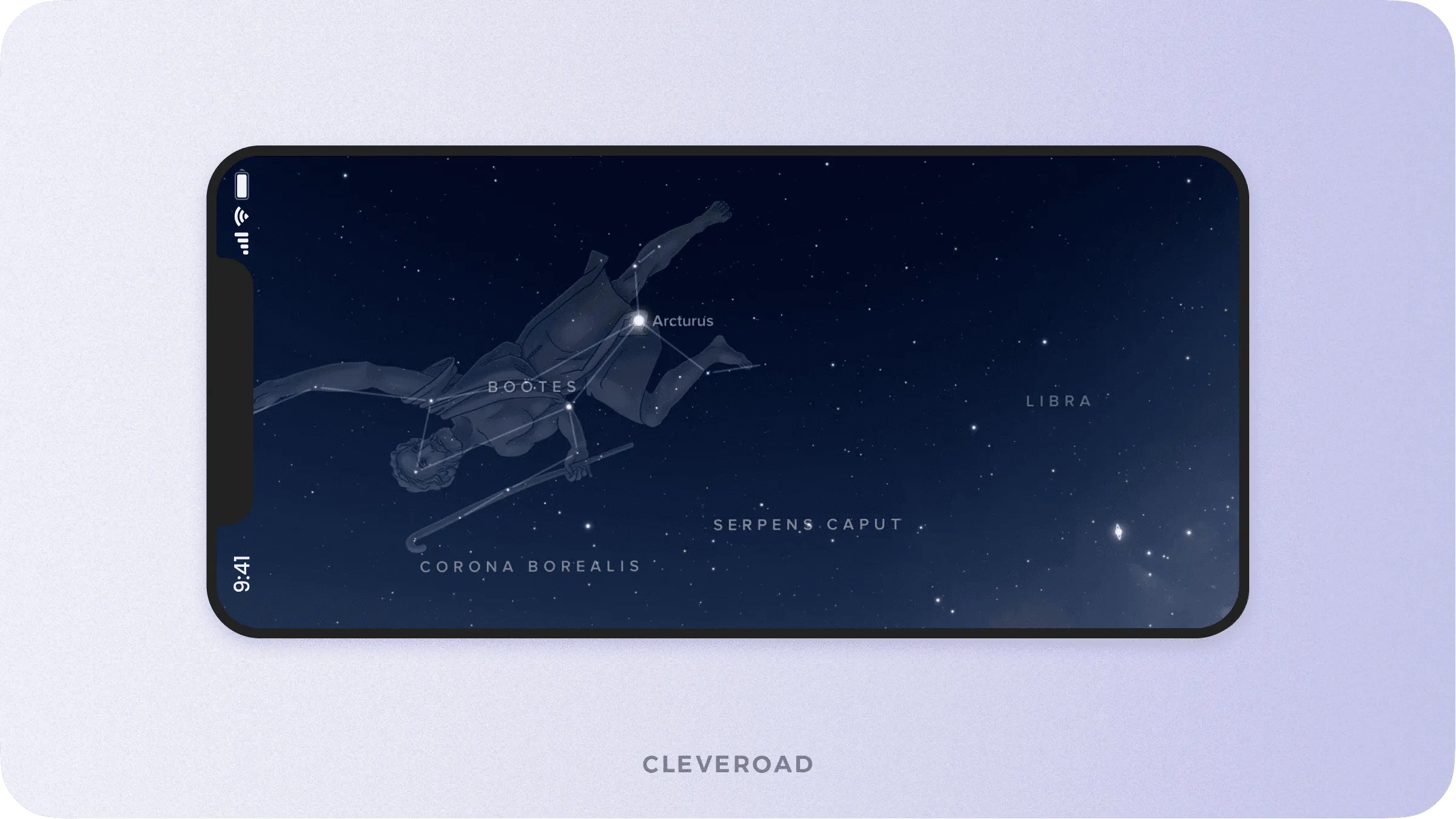
Sky Guide
Besides Sky Guide, the AR solutions for astronomy include Star Walk, Sky View, and Star Chat..
IKEA Place
This app is a great example of indoor markerless AR. IKEA launched its AR app in order to promote its furniture and let customers know how the new IKEA product will look like at their apartments. There are about 2000 items in this IKEA catalog. IKEA used ARKit to develop this app for Apple devices and AR Core for gadgets running Android.
How to Build Location Based AR Apps
After talking about best examples of location-based AR apps, let's move directly to building such an app.
Step 1. Prepare required data
First of all, you should decide what data you will add to the real world. The easiest way is to build an application like Yelp Monocle or Wikitude Browser that simply displays text information. Developing a game or an app with colorful 3D objects will be more difficult. To create this kind of markerless augmented reality, Unity Engine is a must-have. Unity is the most popular game engine used for creating mobile and computer games.
Step 2. Choose development tool
With no doubt, the most essential step to take is to choose the best location-based AR SDK which will be able to meet all your requests. We considered the most well-known and powerful tools for developing the AR app of this type.
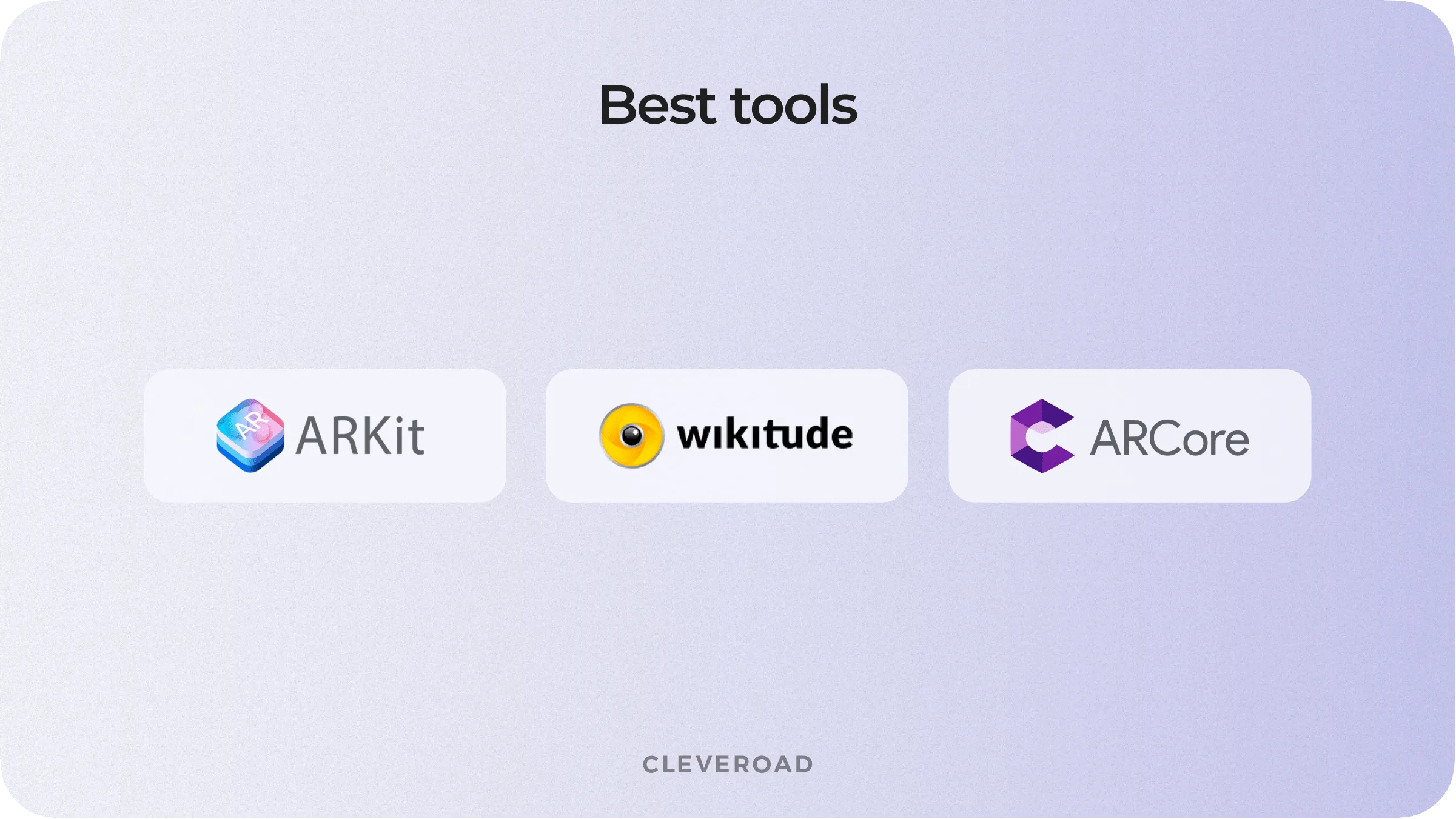
Best tools for creating location-based augmented reality apps
AR Kit by Apple
Previously we have mentioned this SDK, now let's deepen our knowledge. It has the following features:
- Visual Inertial Odometry that combines computer vision and information from the camera to accurately track the environment.
- Scanning both vertical and horizontal environments
- Lighting estimation. On the basis of the amount of light in the real world, this SDK adjusts the amount of light on the virtual model.
- Integration with Unreal and Unity engines.
ARKit 2 now also allows several users to cooperate with each other in a single virtual environment. Besides, it identifies 3D objects and remembers the location where the AR object was left. Also, Apple introduced a new USDZ format that enables developers to share and create AR items in an extremely easy way. It has a major impact on the AR market. But the main drawback of AR Kit is that this SDK is available only for iOS.
Wikitude
Wikitude enables developers to create both marker-based and markerless AR applications. Among the main features of Wikitude are:
- 'Scene Recognition' which can recognize and track large objects like rooms, landscapes, buildings, etc;
- SLAM technology;
- It has finally got a Unity plugin, so it became easier to implement created 3D objects into the app;
- geolocation support;
- integration with various frameworks like Xamarin and Cordova.
This SDK allows creating location-based augmented reality apps for Android, iOS and AR glasses. But Wikitude will cost you a pretty penny. It has a free trial, but the full version will cost you from 2490 per year.
ARCore by Google
The competition between Google and Apple has already become legendary. The strongest feature of this tool is mapping, which is the most crucial for the development of markerless AR apps. It detects both horizontal and vertical surfaces and has the function of motion tracking.
In AR Core 1.2 Google added the Cloud Anchors, enabling two separate gadgets to manage the same AR objects from different viewing angles. New Vertical Plane Detection Feature allows placing AR items on various vertical surfaces.
Step 3. Integrate geolocation data
While one markerless augmented reality SDK already provides the mapping function, another may not. So you should integrate geolocation on your own.
GPS technology is the most common way to determine outdoor location. The main advantages of GPS are high accuracy and ability to determine your position literally from anywhere in the world. But there is the other side of the coin - GPS tracking is highly energy-intensive. To integrate a geolocation into your app, you should use Android Location services or iOS location service.
We have a separate article about integrating geolocation to your app. Read it or watch our video to easily integrate it.
Discover how to integrate geolocation in your app
So your application already has all the required information and can identify the device's position and location. Now, it's high time to add a list of points of interest to the application. To add the list to Android or iOS applications, you need to enable Google's Places API.
Challenges to Overcome When Building a Location Based Augmented Reality App
Even though the fast development of location recognition technologies, creating good-working location-based apps could be quite challenging. You can face the following obstacles:
Stability of virtual objects
Virtual objects should stay in place even when users move the camera. In this case, the simultaneous localization and mapping (SLAM) technology— a method of simultaneous localization and mapping comes in handy. This markerless tracking technology for augmented reality analyzes the visual scene and tracks the position and orientation of the phone in the house with centimeter accuracy. Due to this, objects that complement the real world remain stationary and do not bounce when the user moves the camera. The technology is quite challenging to implement, but an experienced team of programmers can easily cope with such a task.
Need for high precision
Accuracy is critical for this type of app. Your application must correctly and simultaneously send requests to all required sensors. In addition, the phone's attitude and position must be considered to determine augmented reality location. To comply with such requirements, it is necessary to cooperate with a software vendor that can provide specialists who are well acquainted with the features of specific operating systems and devices.
Correct GPS operation
Techniques that calculate a distance between your phone and needed object should be reliable and efficient. Make sure that implemented GPS works without errors. In GPS based AR, a sufficient amount of time should be devoted to testing. All possible bugs should be fixed at the development stage so that the errors are fixed before the app's final version is released.
So, you can see that building a top-notch augmented reality location based app. If you decided that developing a location-based AR app is what you want, you can contact us. First, we will properly estimate the cost of your project and then our skilled coders and designers will do their best to create a markerless AR app meeting all your needs.
We regularly post articles about how to build various types of apps, so you can subscribe to our newsletter and never miss guides on creating applications.
Cleveroad’s Expertise in the Development of Location-Based AR Apps
Cleveroad is a Northern European software development vendor from Estonia. We have been acting in the IT industry since 2011, helping businesses with solutions that are highly increasing their efficiency. For more than 10 years of work, we have had more than 170 successful projects.
So what are the main benefits of choosing Cleveroad to develop an AR app:
- On-demand services of any complexity — creating an application from scratch or adding AR solutions to an existing app
- Comprehensive quality assurance — a team of QA engineers will control the project at every stage using both manual and automatic testing
- Post-release maintenance — we are always ready to update and improve your app
- Scalability — you can make the team bigger or smaller based on your needs
- With our experience in location-based AR apps development you can be sure that you will get a high-quality result
Speaking about our experience, we can cite the AR Face Detection case as an example.
The app was created by our Android developers to share an example of an open source AR application with people keen on the newest technologies.
Solutions Cleverad’s team has implemented:
- Ability to use both frontal and rear cameras
- Analysis of posture and head tilt
- Motion analysis and smoothness of virtual objects
The main function of the application is to place any image or text above the user's head in real-time; the image will follow the movements of the head. It is also possible to process several faces at the same time.

AR Face Detection
So if you have an idea, contact us, we will bring it to life. We can create an app that helps you to achieve all your business goals.
Make your AR app with Cleveroad
We will create the best AR solution for you, taking into account all your requirements
Location-based AR primarily relies on GPS, accelerometer, digital compass, and other technologies to identify a phone's location and position with a high level of accuracy. Through the fact that all modern devices are equipped with these sensors, augmented reality is available for every mobile device owner.
The mechanism of work of such an app is the following: your application sends queries to sensors. After the app gets the needed data, the app compares it with information about points of interest (POI) and defines where it should add virtual data to the real world.
After talking about the best examples of location-based AR apps, let's move directly to building such an app.
- Step 1. Prepare required data
- Step 2. Choose a development tool
- Step 3. Integrate geolocation data
There are three main steps you need to follow to create a location-based AR app.
- Step 1. Prepare required data
- Step 2. Choose the development tool
- Step 3. Integrate geolocation data
AR technology can offer much more than just an incredible gaming experience. Here's the list of industries that can benefit from creating AR mobile applications.
- Tourism. Navigation applications with location-based augmented reality dramatically improve the effectiveness of navigation systems.
- Education. AR brings 3D and 2D objects. They changed the tiresome education process.
- Healthcare. Besides the indisputable utility of marker-based AR for the healthcare industry, location-based AR can also come in handy.
- Advertising. Many companies began using AR in advertising. It is much cheaper than traditional printed ads and stimulates customers to buy goods or services by introducing a new way of AR experience.
- Entertainment. Putting virtual objects into the real world is funny. Therefore gaming and entertainment seem to be industries gaining the most profit from implementing location-based AR technology.

Evgeniy Altynpara is a CTO and member of the Forbes Councils’ community of tech professionals. He is an expert in software development and technological entrepreneurship and has 10+years of experience in digital transformation consulting in Healthcare, FinTech, Supply Chain and Logistics
Give us your impressions about this article
Give us your impressions about this article